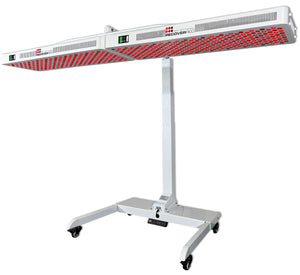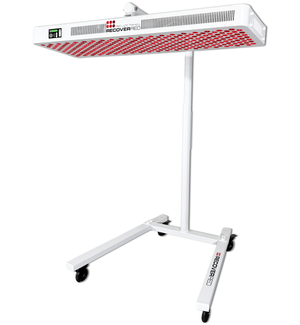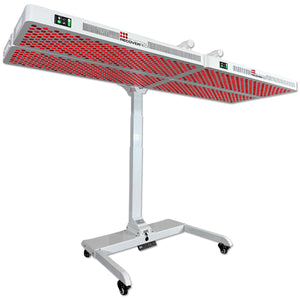Psoriasis, a chronic autoimmune condition that manifests in the form of itchy, scaly, and often painful patches of skin, affects millions of people worldwide. While modern medicine has made significant strides in managing this condition, emerging research suggests that a non-invasive and potentially effective treatment may lie in the realm of Red Light Therapy (RLT). This innovative approach harnesses the power of specific wavelengths of light to alleviate the symptoms of psoriasis, offering a beacon of hope to those living with this challenging skin disorder.
Understanding Red Light Therapy
Red Light Therapy, alternatively referred to as low-level laser therapy (LLLT) or photobiomodulation, entails the exposure of the skin to minimal levels of red or near-infrared light. This light penetrates the skin, prompting various cellular responses that can promote healing and reduce inflammation [1].
While the precise mechanisms are still under investigation, studies have shown that red light therapy can enhance cellular energy production, improve circulation [2], and modulate the immune response, all of which play a vital role in managing the symptoms of psoriasis.
The Potential of Red Light Therapy in Psoriasis Treatment
Research in recent years has unveiled the promising potential of red light therapy in managing the symptoms of psoriasis. Several studies have demonstrated that red light therapy can help alleviate the characteristic redness, scaling, and thickness of psoriatic plaques.
By stimulating cellular repair and reducing inflammation, red light therapy has shown the ability to promote the shedding of skin cells and encourage the growth of healthier skin, leading to a visible improvement in the appearance of affected areas. Furthermore, the non-invasive nature of this therapy makes it an attractive alternative to traditional treatments, which can sometimes carry undesirable side effects.
Clinical Trials and Evidence

Numerous clinical trials and research studies have delved into the efficacy of red light therapy for psoriasis. A study published in the Journal of Lasers in Medical Science in 2017 highlighted the potential of low-level light/laser therapy (LLLT) in the treatment of psoriasis. While acknowledging the relatively limited scale of the trials, the study emphasized the promising attributes of near-infrared (NIR) and visible red light with low energy. These specific wavelengths were noted for their strong penetration capabilities and their ability to stimulate photobiomodulation, offering hope for the effective management of psoriasis symptoms. [3]
While more extensive research is needed to fully understand the long-term effects and optimal treatment protocols, the initial findings provide a compelling foundation for the integration of RLT into mainstream psoriasis management strategies.
Safe and Non-Invasive Treatment Option
One of the key advantages of red light therapy in psoriasis treatment is its safety and non-invasive nature [4]. Unlike some conventional therapies that may carry risks of systemic side effects or require frequent visits to healthcare facilities, red light therapy can often be administered at home using specialized devices.
This convenience not only improves accessibility but also empowers individuals to take an active role in managing their condition, fostering a sense of autonomy and control over their treatment regimen.
Integration into Holistic Treatment Approaches
While red light therapy shows promise as a standalone treatment for psoriasis, it also complements existing therapeutic approaches. Integrating red light therapy with traditional treatments such as topical medications or phototherapy can potentially enhance their effectiveness, leading to more comprehensive and synergistic outcomes.
Additionally, the psychological benefits of red light therapy, including its potential to reduce stress and improve mood, contribute to a holistic approach to psoriasis management, addressing both the physical and emotional aspects of the condition.
Bottomline
As research continues to shed light on the remarkable potential of Red Light Therapy in alleviating the burdens of psoriasis, this innovative treatment approach offers a glimmer of hope for individuals navigating the challenges of this chronic skin disorder.
With its non-invasive nature, encouraging clinical evidence, and potential integration with existing therapies, red light therapy stands poised as a promising avenue in the ongoing quest to improve the quality of life for those living with psoriasis. As further advancements unfold, the glow of this therapeutic light continues to illuminate a path toward a more manageable and fulfilling journey for psoriasis patients worldwide.
For those seeking reliable and effective Red Light Therapy products, RecoverRed offers a premium lineup of specialized devices designed to deliver the precise wavelengths and intensities necessary for therapeutic benefits. With a commitment to quality and innovation, RecoverRed empowers individuals to embark on their journey toward skin wellness with confidence and convenience.
Embrace the potential of Red Light Therapy, and embark on a path towards renewed skin health and overall well-being. With ongoing advancements and a growing understanding of its efficacy, this cutting-edge therapy stands as a beacon of hope for those seeking effective, non-invasive solutions for managing psoriasis and enhancing their quality of life.
References:
- Hamblin MR. Mechanisms and applications of the anti-inflammatory effects of photobiomodulation. AIMS Biophys. 2017;4(3):337-361. doi:10.3934/biophy.2017.3.337
- Podogrodzki, J., Lebiedowski, M., Szalecki, M., Kępa, I., Syczewska, M., & Jóźwiak, S. (2016). Wpływ niskoenergetycznej laseroterapiina skorny przepływ krwi [Impact of low level laser therapy on skin blood flow]. Developmental period medicine, 20(1), 40–46.
- Zhang, P., & Wu, M. X. (2018). A clinical review of phototherapy for psoriasis. Lasers in medical science, 33(1), 173–180. https://doi.org/10.1007/s10103-017-2360-1




